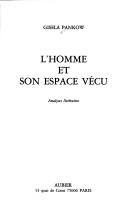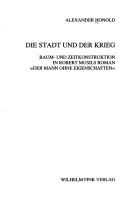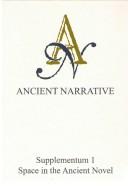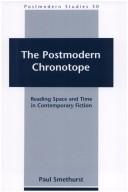| Listing 1 - 10 of 130 | << page >> |
Sort by
|

ISBN: 2700721055 9782700721058 Year: 1986 Publisher: Paris Aubier
Abstract | Keywords | Export | Availability | Bookmark
 Loading...
Loading...Choose an application
- Reference Manager
- EndNote
- RefWorks (Direct export to RefWorks)
Book
ISBN: 1443894087 9781443894081 9781443890441 1443890448 Year: 2016 Publisher: Newcastle upon Tyne, [England] : Cambridge Scholars Publishing,
Abstract | Keywords | Export | Availability | Bookmark
 Loading...
Loading...Choose an application
- Reference Manager
- EndNote
- RefWorks (Direct export to RefWorks)
This book is a product of the XI International Conference on English Language and Literary Studies held in Montenegro in 2014. The "old spaces" were taken as a metaphorical tool for reintroducing a wide range of established topics with new approaches. Space was, thus, understood as physical, mechanical, continuous, linear, as measurable and symbolic, as subjective and relational, and as aesthetic. It was found on maps, in architecture, on theatre stages, in books, in hearts, in one's identity, in time, and in theses and theories from the Aristotelian topos to Einstein's construct of space-time
Book
ISBN: 9781783086245 9781783086252 1783086254 1783086246 1783086238 9781783086238 Year: 2017 Publisher: New York Anthem Press
Abstract | Keywords | Export | Availability | Bookmark
 Loading...
Loading...Choose an application
- Reference Manager
- EndNote
- RefWorks (Direct export to RefWorks)
Before Albert Einstein proposed the concept of four-dimensional spacetime, late Victorian scientists, radical philosophers and writers were discussing the possibility of a different kind of fourth dimension. Before Einstein offers the first book-length examination of the impact of pre-Relativity four-dimensional theory on literature and culture at the turn of the twentieth century.
Book
ISBN: 9789038221021 9038221029 Year: 2013 Publisher: Gent Academia press
Abstract | Keywords | Export | Availability | Bookmark
 Loading...
Loading...Choose an application
- Reference Manager
- EndNote
- RefWorks (Direct export to RefWorks)
In his essay 'Des espaces autres' (1984) Michel Foucault announced that after the nineteenth century, which was dominated by a historical outlook, the current century might rather be the century of space. His prophecy has been fulfilled: the end of the twentieth century witnessed a 'spatial turn' in humanities which was perhaps partly due to the globalisation of our modern world. Inspired by the spatial turn in the humanities, this volume presents a number of essays on the ideological role of space in literary texts. The individual articles analyse ancient and modern literary texts from the angle of the most recent theoretical conceptualisations of space. The focus throughout is on how the 'experience' of space is determined by dominant political, philosophical or religious ideologies and how, in turn, 'the description of spaces in literature' is employed to express, broadcast or deconstruct this experience. By bringing together ancient and modern texts, this volume hopes to stimulate discussion among disciplines and across continents.
Space and time in literature. --- Space and time as a theme in literature --- 82.04 --- 82.04 Literaire thema's --- Literaire thema's

ISBN: 377053008X Year: 1995 Publisher: München Fink
Abstract | Keywords | Export | Availability | Bookmark
 Loading...
Loading...Choose an application
- Reference Manager
- EndNote
- RefWorks (Direct export to RefWorks)

ISBN: 9080739022 9491431005 9789491431005 9789080739024 Year: 2002 Publisher: Groningen Barkhuis
Abstract | Keywords | Export | Availability | Bookmark
 Loading...
Loading...Choose an application
- Reference Manager
- EndNote
- RefWorks (Direct export to RefWorks)
This special issue of Ancient Narrative Supplementum 1, entitled 'Space in the Ancient Novel', brings together a collection of revised papers, originally presented at the International conference under the same title organized by the Department of Philology (Division of Classics) of the University of Crete and held in Rethymnon, on May 14-15, 2001. This conference inaugurated what is hoped to become a new series of biennial International meetings on the Ancient Novel (RICAN, Rethymnon International Conferences on the Ancient Novel) which aspires to continue the reputable tradition of the Groni
Book
ISBN: 0199333912 1306291259 0199333904 0199359709 9780199333912 9780199333905 Year: 2014 Publisher: New York
Abstract | Keywords | Export | Availability | Bookmark
 Loading...
Loading...Choose an application
- Reference Manager
- EndNote
- RefWorks (Direct export to RefWorks)
This title uses Walter Benjamin's philosophy of history to examine four canonical Victorian novels by Dickens, Hardy, and James. Throughout its chapters, the monograph deploys the dialectical notion of the 'constellation' to read moments in novels in which past and present interpenetrate and the ways these writers open out the representation of the city to new modes of articulation and-through narrative perception- the reader's perception of the phenomena of the city, its place as the exemplar of modernity, and the ways in which it determines subjectivity.
Book
ISBN: 1469657120 1469657112 Year: 1979 Publisher: Chapel Hill : University of North Carolina Press,
Abstract | Keywords | Export | Availability | Bookmark
 Loading...
Loading...Choose an application
- Reference Manager
- EndNote
- RefWorks (Direct export to RefWorks)
Space and time in literature. --- German fiction --- History and criticism. --- Tieck, Ludwig, --- Novalis, --- Criticism and interpretation. --- Space and time as a theme in literature
Book
ISBN: 9782356133403 2356133402 Year: 2020 Publisher: Bordeaux Ausonius
Abstract | Keywords | Export | Availability | Bookmark
 Loading...
Loading...Choose an application
- Reference Manager
- EndNote
- RefWorks (Direct export to RefWorks)
Espace --- Dans la littérature. --- Space and time in literature --- Space and time as a theme in literature --- Ovid, --- Ovidius Naso, Publius. --- Space and time in literature.

ISBN: 9789042015135 9789004483248 Year: 2000 Publisher: Leiden;Boston BRILL
Abstract | Keywords | Export | Availability | Bookmark
 Loading...
Loading...Choose an application
- Reference Manager
- EndNote
- RefWorks (Direct export to RefWorks)
The Postmodern Chronotope is an innovative interdisciplinary study of the contemporary. It will be of special interest to anyone interested in relations between postmodernism, geography and contemporary fiction. Some claim that postmodernism questions history and historical bases to culture; some say it is about loss of affect, loss of depth models, and superficiality; others claim it follows from the conditions of post-industrial society; and others cite commodification of place, Disneyfication, simulation and post-tourist spectacle as evidence that postmodernism is wedded to late capitalism. Whatever postmodernism is, or turns out to have been, it is bound up in rethinking and reworking space and time, and Paul Smethurst's intervention here is to introduce the postmodern chronotope as a term through which these spatial and temporal shifts might be apprehended. The postmodern chronotope constitutes a postmodern world-view and postmodern way of seeing. In a sense it is the natural successor to a modernist way of seeing defined through cubism, montage and relativity. The book is arranged as follows: • Part 1 is an interdisciplinary study casting a wide net across a range of cultural, social and scientific activity, from chaos theory to cinema, from architecture to performance art, from IT to tourism. • Part 2 offers original readings of a selection of postmodern novels, including Graham Swift's Waterland and Out of this World , Peter Ackroyd's Hawksmoor and First Light , Alasdair Gray's Lanark , J. M. Coetzee's Foe , Marina Warner's Indigo , Caryl Phillips' Cambridge , and Don DeLillo's The Names and Ratner's Star .
| Listing 1 - 10 of 130 | << page >> |
Sort by
|

 Search
Search Feedback
Feedback About UniCat
About UniCat  Help
Help News
News